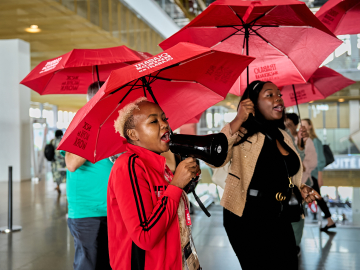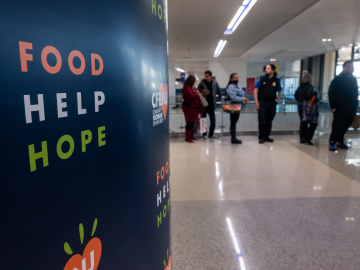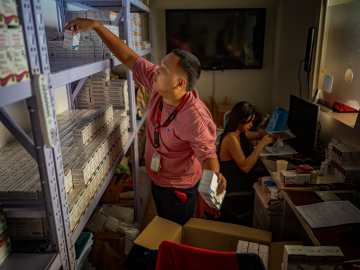Why the World’s Adolescent Girls Need Our Support
Adolescence is often called a transitional phase—a necessary bridge between childhood and adulthood. But, while the adolescent years may be short, teens’ experiences often have far-reaching impacts on whether they can complete their education, enjoy good health, and support themselves and their families. The funding cuts and policy shifts disrupting health and development programs around the world have broad repercussions, and the world’s teenagers—particularly teenage girls—are especially vulnerable.
- Every three seconds, a girl is married before the age of 18, threatening her life and health, and limiting her prospects for a safe, productive future.
- Conflicts and natural disasters are particularly dangerous for adolescent girls, who often are the victims of violence and lack access to essential services, including health care, education, and social protection.
- 11.7 million women and girls could be denied access to contraceptive care this year due to the U.S. foreign assistance freeze, upping the risk of unintended pregnancies and maternal deaths.
Without urgent intervention, the ripple effects will be devastating: more child marriages, school dropouts, and economic hardships that will persist for generations. But apprehension is growing that funding dedicated to adolescent girls will continue to decline.
The cost of this failure would be high—and not just on girls’ lives. When countries don’t invest in adolescent wellbeing—including increasing access to education and health services, reducing child marriage, and ending female genital mutilation, among other interventions—economic and social losses are significant. The cost of inaction could reach $110 trillion between now and 2050—a staggering loss equivalent to 7.7% of the GDP of countries that account for 80% of the world's population.
Globally, while commitments such as the Beijing Declaration and Platform for Action and the International Conference on Population and Development Program of Action delivered advances in improving adolescent girls’ health and wellbeing, progress has been uneven—especially in low- and-middle-income countries, where girls continue to be left behind.
Yet clear evidence shows that investing in adolescent girls yields transformative results. Girls who stay in school are more likely to secure stable employment, contribute to household income, and pass on the benefits of education to the next generation. Women who receive quality health care as adolescents are more likely to give birth to healthier babies and access better economic opportunities.
To uphold these long-range gains, interventions need to be informed by comprehensive evidence—such as Population Council research identifying the most pressing issues affecting adolescents, refining the critical elements of girl-centered programs, and helping organizations, donors, and policymakers steer limited resources to the most effective interventions. We’ve found that a multisectoral approach—addressing the diverse needs of adolescent girls and combining programming across education, health and economic empowerment—has the greatest impact.
One example: The Adolescent Girls Initiative-Kenya, which provides financial literacy training, health education, access to safe spaces, financial incentives to stay in school, and community programs promoting the value of education for young adolescent girls in marginalized settings in Kenya. These interventions helped more than half of a group of previously out-of-school girls enroll and stay in school—and delayed marriage and pregnancy for years after the program’s end. Girls in the program were 20% less likely to be married and half as likely to ever give birth four years after completing the program.
Prioritizing investments so that they benefit girls but also involve girls from the beginning—consulting them about their needs and priorities—is key. This approach not only empowers girls by giving them a voice in the decision-making process; it also enhances the impact of interventions by addressing specific needs identified by the girls themselves.
Girls are demanding that we listen. Last September, on the UN Summit of the Future sidelines, the Girls Deliver community of over 70 girl-centered organizations called on member states to heed adolescent girls’ calls for increased commitments to adolescent girls’ rights, as well as meaningful inclusion in the 2030 Agenda for Sustainable Development and beyond.
Collaboration across sectors that allow stakeholders to pool resources, share best practices, and coordinate efforts also allow us to create more cohesive and sustainable initiatives that will reap major benefits. A recent report by the Population Council, the Center for Global Development, and the World Bank Group estimated that every dollar invested in adolescent girls’ empowerment in Africa by 2040 can generate more than a tenfold return in economic impact, with potential gains of $2.4 trillion.
There is a clear pathway to achieving these economic gains and strong evidence to back a girl-centered approach. Country leaders, donors, and organizations working with and for girls must bridge the growing funding gaps and support evidence-based programming—so that girls can grow up and thrive.
Evalin Karijo, MPH, and Karen Austrian, PhD, MPH are the associate director and director, respectively, of the Population Council’s Girl Innovation, Research, and Learning (GIRL) Center—a global research hub that generates, synthesizes, and translates evidence on adolescents to support investments that transform their lives, especially for girls.
Join the 50,000+ subscribers in 170+ countries who rely on Global Health NOW summaries and exclusive articles for the latest public health news. Sign up for our free weekday newsletter, and please share the link with friends and colleagues.
Wajir girls reading together. icon (be one) K / Nicholas Oreyo






